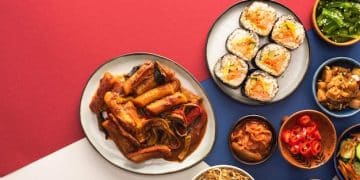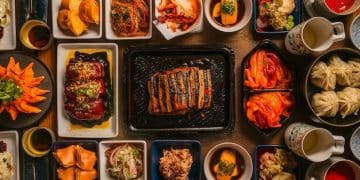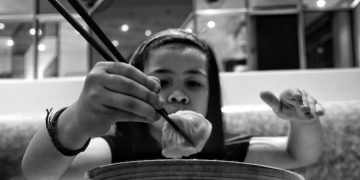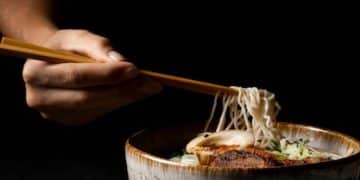Indulge Your Senses: Exploring Chinese Drama Food Culture
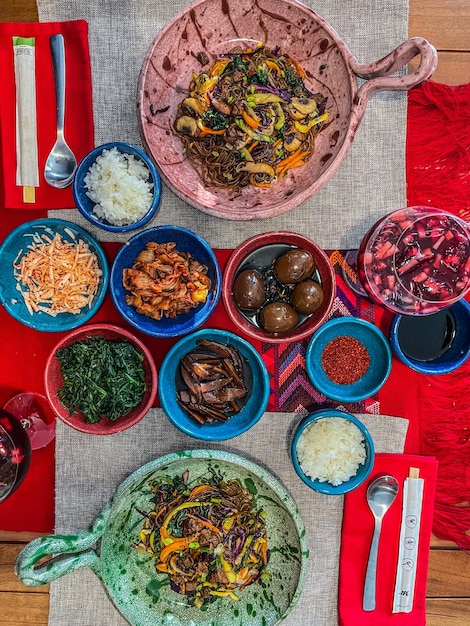
Advertisements
Chinese drama food culture offers a unique lens into Chinese society, showcasing regional cuisines and culinary traditions that enrich storytelling and captivate audiences worldwide.
Step into the delectable world of Chinese dramas, where food isn’t just a prop, but a flavorful character in its own right. From heartwarming family meals to elaborate imperial banquets, get ready to explore the rich tapestry of Chinese drama food culture, one tantalizing scene at a time.
Anúncios
Unveiling the Significance of Food in Chinese Dramas
Food in Chinese dramas is more than sustenance; it’s a powerful storytelling tool. It reflects social status, expresses emotions, and strengthens bonds between characters. By exploring these culinary narratives, we gain deeper insights into Chinese culture and values.
Food as a Reflection of Social Status
The types of food characters consume often reflect their social standing. Lavish banquets with exotic dishes indicate wealth and power, while simple meals of rice and vegetables might depict poverty or humility.
Anúncios
Food as an Emotional Messenger
Sharing a meal can be a subtle expression of affection, a peace offering after a quarrel, or a way to convey unspoken feelings. The act of cooking and serving food is often imbued with love and care.
- Food strengthens familial bonds, especially during Lunar New Year celebrations.
- Specific dishes can evoke memories or symbolize significant events.
- The absence of food can highlight hardship or neglect.
Ultimately, food acts as a vehicle for cultural transmission, allowing viewers to connect with Chinese traditions on a deeply personal level, enhancing their understanding and appreciation of the narratives unfolding on screen.
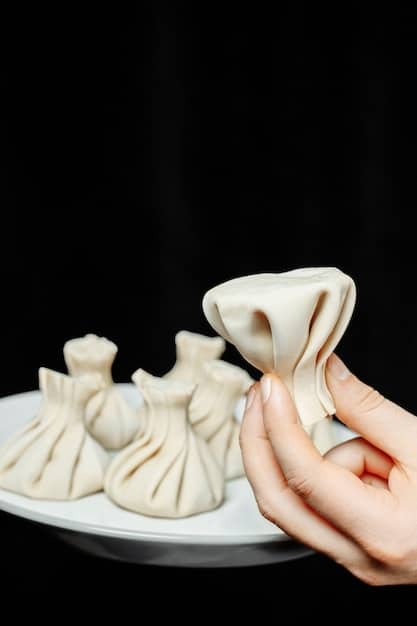
Popular Dishes Commonly Featured in Chinese Dramas
Certain dishes appear frequently in Chinese dramas, becoming almost as recognizable as the actors themselves. These culinary staples vary by region, reflecting the diverse gastronomic landscape of China.
Noodles: A Symbol of Longevity and Unity
Long noodles, often eaten during birthdays or celebrations, symbolize a wish for a long and prosperous life. Sharing a bowl of noodles can also represent unity and togetherness.
Dumplings: Embodiments of Good Fortune
Dumplings, especially popular during the Lunar New Year, are shaped like ancient Chinese money and represent wealth and good fortune. Each family often has its own unique dumpling recipe passed down through generations.
The presentation and preparation methods further add layers of meaning. A simple bowl of plain congee might signify a character’s illness or vulnerability, while a meticulously prepared Peking duck suggests a formal occasion or a display of hospitality.
- Peking Duck: A symbol of imperial cuisine, often served during important events.
- Hot Pot: A communal dish representing togetherness and warmth.
- Mooncakes: Eaten during the Mid-Autumn Festival, symbolizing family reunion.
The widespread presence of these dishes not only enhances the authenticity of the narratives but also serves as an invitation for viewers to explore and appreciate the depth of Chinese gastronomic heritage.
Regional Cuisine Showcases in Chinese Dramas
Chinese dramas often highlight the unique culinary traditions of different regions, showcasing the diversity of Chinese cuisine. From the spicy flavors of Sichuan to the delicate seafood dishes of the coastal provinces, each region has its own distinct culinary identity.
Sichuan Cuisine: A Fiery Culinary Adventure
Known for its bold flavors and liberal use of chili peppers and Sichuan peppercorns, Sichuan cuisine adds a fiery kick to many Chinese dramas. Dishes like Mapo Tofu and Kung Pao Chicken are frequently featured.
Cantonese Cuisine: Emphasizing Freshness and Balance
Cantonese cuisine, with its focus on fresh ingredients and subtle flavors, offers a more delicate counterpoint to Sichuan cuisine. Dim sum and seafood dishes are prominent examples.
The impact of regional culinary practices extends beyond mere representation; it shapes character identities, enriches plotlines, and deepens audience engagement. Consider the preference for wheat-based foods in northern dramas versus rice-based meals in southern productions.
- Shanghai Cuisine: Known for its sweet and savory flavors, often featuring braised dishes.
- Hunan Cuisine: Similar to Sichuan, but with a focus on sour and spicy flavors.
- Jiangsu Cuisine: Characterized by its meticulous preparation and elegant presentation.
By exploring these regional specialties, viewers gain a comprehensive understanding of the culinary diversity within China, fostering an appreciation for the nuances of each region’s unique gastronomic contributions.
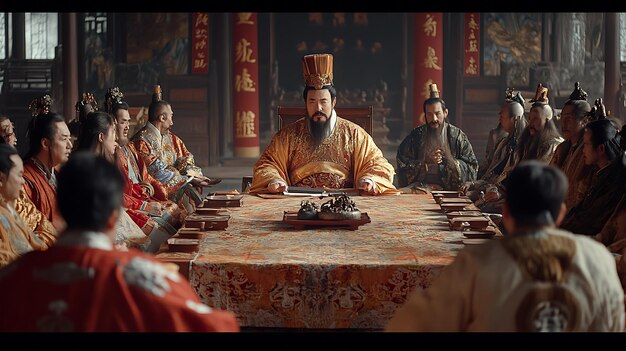
The Evolution of Food Presentation in Chinese Dramas
The way food is presented in Chinese dramas has evolved significantly over time, reflecting changing culinary trends and production values. From simple, rustic presentations to elaborate, stylized displays, the visuals have become increasingly important.
Historical Dramas: Authenticity and Tradition
Historical dramas often strive for authenticity, showcasing traditional cooking methods and presentation styles. Dishes are often served in classic porcelain or earthenware.
Modern Dramas: Fusion and Innovation
Modern dramas embrace fusion cuisine and innovative plating techniques, reflecting contemporary culinary trends. Food is often presented in a more Westernized style.
This evolution not only showcases changes in culinary aesthetics but also reflects broader societal shifts and cultural influences. It’s a dynamic interplay between tradition and modernity, mirroring the ongoing evolution of Chinese identity.
- The use of food styling techniques to enhance visual appeal.
- The incorporation of international culinary influences.
- The emphasis on healthy and sustainable eating habits.
By observing these shifts, audiences can gain insights into how Chinese dramas adapt and evolve, staying relevant and engaging in an ever-changing world.
Impact of Chinese Drama Food Culture on Global Cuisine Trends
The popularity of Chinese dramas has had a significant impact on global cuisine trends, introducing new dishes and culinary practices to a wider audience. Many viewers are inspired to try the foods they see on screen, leading to increased demand for Chinese ingredients and restaurants.
The “Drama Effect” on Restaurant Bookings
Restaurants featured in popular dramas often experience a surge in reservations as viewers seek to recreate the on-screen dining experience. Certain dishes become instant hits, driving demand for specific ingredients.
Influence on Home Consumption of Certain Foods
Home cooks are also inspired to experiment with Chinese recipes, leading to increased consumption of ingredients like tofu, bok choy, and various types of noodles. Online communities dedicated to Chinese cooking have flourished.
Beyond driving consumption, these dramas foster a greater awareness and appreciation of Chinese culinary arts globally. They promote cultural exchange and inspire culinary innovation, leading to fusion dishes and creative interpretations of classic recipes.
- The rise of Chinese food blogs and social media influencers.
- The increasing availability of Chinese ingredients in Western supermarkets.
- The fusion of Chinese and Western culinary traditions.
This cultural synergy highlights the power of media in shaping global gastronomic landscapes, enriching culinary experiences across diverse communities.
Experiencing Chinese Drama Food Culture: A Viewer’s Guide
For viewers eager to immerse themselves in Chinese drama food culture, there are many ways to enhance their experience. From trying authentic recipes to visiting local Chinese restaurants, here are some tips to get started.
Finding Authentic Recipes Online
Numerous websites and channels offer authentic Chinese recipes, often with step-by-step instructions and helpful tips. Look for recipes that are specific to the region or drama you are interested in.
Visiting Local Chinese Restaurants
Explore the Chinese restaurants in your area, seeking out dishes that are featured in your favorite dramas. Don’t be afraid to ask the staff for recommendations or to try something new.
Enhancing your viewing experience involves not only trying the food being showcased, but also understanding the cultural context behind them. Engage with online communities, attend cultural events, and delve into the history and folklore associated with particular dishes.
- Learning basic Chinese culinary techniques.
- Exploring regional Chinese cookbooks.
- Joining online forums and social media groups dedicated to Chinese cuisine.
By actively participating in these activities, you transcend the role of a passive observer and become an engaged participant in the vibrant world of Chinese drama food culture.
| Key Concept | Brief Description |
|---|---|
| 🍜 Noodles | Symbolize longevity and unity in celebrations. |
| 🥟 Dumplings | Represent wealth and good fortune, especially during Lunar New Year. |
| 🌶️ Sichuan Cuisine | Features bold, spicy flavors using chili peppers and Sichuan peppercorns. |
| 🥢 Cantonese Cuisine | Emphasizes fresh ingredients and balanced, subtle flavors. |
Frequently Asked Questions
▼
Food in Chinese dramas symbolizes emotions, strengthens relationships, and reflects social status. It’s used to convey unspoken feelings, offering a deeper connection to the narrative.
▼
Common dishes include noodles (symbolizing longevity), dumplings (representing wealth), Peking duck (for imperial events), and hot pot (for togetherness), each adding cultural context.
▼
Sichuan cuisine brings spicy flavors, while Cantonese cuisine offers freshness. Shanghai cuisine emphasizes braised dishes, providing a diverse culinary experience across different dramas.
▼
Chinese dramas increase demand for Chinese ingredients, inspire home cooking, and boost restaurant bookings. This introduces new dishes and fosters culinary innovation globally.
▼
Viewers can find authentic recipes, explore local Chinese restaurants, learn basic culinary techniques, and engage with online communities, enhancing understanding and appreciation.
Conclusion
Exploring **Chinese drama food culture** offers a delightful journey into the heart of Chinese society. Through the lens of food, we discover not only the diverse culinary landscape but also the rich cultural values and traditions that shape these captivating stories. So, grab your chopsticks and prepare for a feast for the senses!

